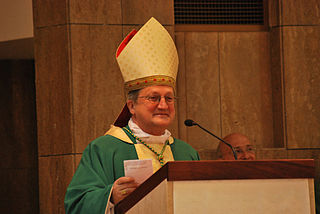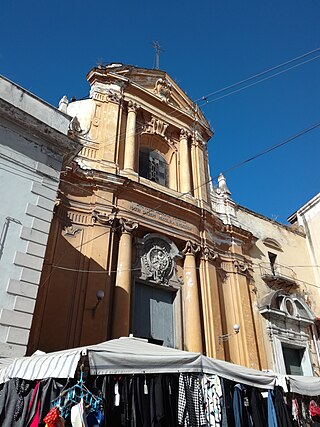Related Research Articles

Alcamo is the fourth-largest town and commune of the Province of Trapani, Sicily, with a population of 44.925 inhabitants. It is on the borderline with the Metropolitan City of Palermo at a distance of about 50 kilometres from Palermo and Trapani.

Pazin is a town in western Croatia, the administrative seat of Istria County. It is known for the medieval Pazin Castle, the former residence of the Istrian margraves.

Daniello Bartoli, SJ was an Italian Jesuit writer and historiographer, celebrated by the poet Giacomo Leopardi as the "Dante of Italian prose"

The properties of the Holy See are regulated by the 1929 Lateran Treaty signed with the Kingdom of Italy. Although part of Italian territory, some of them enjoy extraterritoriality similar to those of foreign embassies, including tax exemptions. Nonetheless, those visiting these properties are generally required to follow the immigration rules of Italy. For example, American seminarians at the Pontifical North American College need an Italian visa, despite residing, and studying, in extraterritorial property of the Holy See.

Vizzini is a town and comune in the Metropolitan City of Catania, on the island of Sicily, southern Italy. It is located 60 kilometres (37 mi) from Catania in the Hyblaean Mountains, on the most northwesterly slopes of Monte Lauro.

There are more than 930 churches in Rome, which makes it the city with the largest number of churches in the world. Almost all of these are Catholic.

The Archdiocese of Bologna is a Latin Church ecclesiastical territory or archdiocese of the Catholic Church in Northern Italy. The cathedra is in the cathedral church of San Pietro, Bologna. The current archbishop is Cardinal Matteo Zuppi, who was installed in 2015.

Benedetto Pamphili was an Italian cardinal, patron of the arts and librettist for many composers.

The Church of the Gesù, known also as the Saint Mary of Jesus or the Casa Professa, is a Baroque-style, Roman Catholic church established under the patronage of the Jesuit order, and located at Piazza Casa Professa 21 in Palermo, region of Sicily, Italy.

Enrico dal Covolo SDB is a Catholic bishop and Italian theologian, Assessor of the Pontifical Committee for Historical Sciences from 15 January 2019. He previously served as the rector of the Pontifical Lateran University from his appointment on 30 June 2010 until 2 June 2018. In addition he was also the postulator of the cause of canonization of Pope John Paul I from 2003 until 2016.

Giuseppe Astarita was an Italian architect and engineer of the late-Baroque or Rococo period. He was a pupil of Domenico Antonio Vaccaro and collaborated with Ferdinando Sanfelice; his style is influenced by Guarino Guarini. He worked on the following buildings, sometimes in work of reconstruction.

Angelo Italia was an Italian Jesuit and Baroque architect, who was born in Licata and died in Palermo. He designed a number of churches in Sicily, and later worked to reconstruct three cities following the 1693 Sicily earthquake.

The Chiesa del Gesù is a Catholic church located in Alcamo, in the province of Trapani, Sicily, southern Italy. It is the second largest church in Alcamo, after the basilica di Santa Maria Assunta.

The Basilica of Santa Maria del Canneto, or Santa Maria Formosa, was a sixth-century Byzantine church erected in Pola under the patronage of Maximianus, bishop of Ravenna. The structure was damaged at the time of the Venetian sack of Pola in 1243, and building material was subsequently taken from the ruins and primarily incorporated into the Marciana Library and the Basilica of Saint Mark in Venice. Of the large, triple-nave church, comparable in splendour to the Euphrasian Basilica in Parenzo, only one of the lateral chapels survives. It constitutes the sole construction in Pola dating to the Byzantine period.

The Pontifical Lombard Seminary of Saints Ambrose and Charles in Urbe is an ecclesiastical institution that serves as a residence for and trains diocesan priests who have been sent to Rome by their bishop to pursue an advanced degree or follow a specialized course of study at one of the pontifical universities there.
Cristoforo Rampelli was an Istrian Italian jurist, vicar, and captain of the County of Pisino from 1674 to 1686.

The Church of the Immaculate Conception of the Blessed Virgin Mary, better known as the Church of Santa Maria Maggiore, and also known as the Baroque church of the Jesuits, is a religious building located in Trieste, in the province and diocese of Trieste; it is the seat of a parish included in the deanery of San Giusto Martire.
References
- 1 2 3 Associazione istriana di studi di storia patria (1904). Pagine istriane periodico scientifico letterario-artistico. ALG. pp. 109–115.
- 1 2 "Della chiesa di Santa Maria Maggiore in Trieste Un tempo dei Padri della Compagnia di Gesù" (PDF). L'Istria (29–30): 116. 1 May 1847.
- ↑ Bertoša, Slaven (2005). Rampel. Istarska Enciklopedija.
- ↑ "Della chiesa di Santa Maria Maggiore in Trieste Un tempo dei Padri della Compagnia di Gesù" (PDF). L'Istria (29–30): 113–120. 1 May 1847.
- ↑ Croatto, Lodovico. La Basilica di S. Silvestro. pp. 260–278.